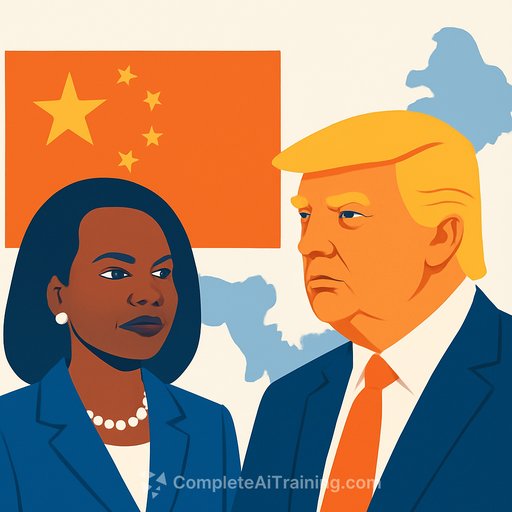Nvidia's Blackwell in China: What Sales Leaders Should Do Now
Nvidia's CEO Jensen Huang says he's hopeful the company can sell Blackwell AI chips in China at some point. The catch: the decision sits with U.S. President Donald Trump, and for now Blackwell is off the table.
After talks in Seoul between Trump and Xi, Trump said China would be "talking to Nvidia and others about taking chips," then clarified, "we're not talking about the Blackwell." Translation: demand exists, policy is the gate.
The headline for sales
Blackwell is Nvidia's top AI processor, and it remains restricted for China under U.S. export rules that also blocked A100 and H100. Huang's view: Nvidia in China benefits both countries, but he also acknowledged the China market could be zero for now.
China is pushing local options, especially Huawei. Even if Nvidia builds a lower-spec Blackwell for China, adoption isn't guaranteed if Beijing steers budgets to domestic vendors.
What this means for your pipeline
- Assume zero revenue from Blackwell in China until policy changes. Don't sandbag your quarter waiting for a license.
- Reallocate focus to the U.S., Europe, and South Korea where demand is strong and partnerships are active.
- Expect buyers in China to pivot to Huawei and local stacks. Deals may shift from imports to domestic supply overnight.
- Pricing discipline holds outside China due to tight supply and heavy AI buildouts. Discounting to "create movement" will likely burn margin without pulling in revenue.
Three scenarios to plan against
- Status quo (most likely): No Blackwell sales in China. Prioritize non-China allocations, lock multi-quarter commitments, and lean on cloud alternatives for customers who can't wait for hardware.
- Limited variant approval: A special China-only Blackwell variant squeaks under thresholds. Treat it as a niche SKU with compliance friction, guarded quantities, and political risk.
- Full approval (least likely): If the door opens, expect quotas, strict licensing, and scrutiny. Build a pre-qualified waitlist and a rapid quote-to-cash path, but don't bake it into targets until you see licenses issued.
Deal strategy: scripts and moves
- For China-based prospects: "We're tracking policy closely. We can scope architecture now, provide TCO and timelines, and convert to POs if/when licenses are confirmed. In the meantime, we can model a Huawei or cloud path as a bridge."
- For global accounts with China ops: Separate China from global demand. Offer split architectures: on-prem Blackwell outside China; cloud or domestic chips inside China.
- For time-sensitive buyers: Push cloud credits or capacity reservations and convert to on-prem later. Make delivery windows explicit in MSAs with policy contingencies.
- For allocation pressure: Tie pricing to firm schedules and prepayments. Avoid soft holds that stall inventory.
Compliance and risk guardrails
- Use standard export-control clauses in all quotes touching China, Macau, Hong Kong, and re-export routes.
- Route every China inquiry through legal and export-compliance before quoting performance, lead times, or SKUs.
- Map reseller chains to the end-user. Get end-use statements early. No "we'll confirm later" language.
- Set hard expirations on quotes; refresh terms if policy changes.
Competitive reality you can't ignore
- Huawei is strong and getting stronger. Expect swift adoption in China's state-linked and strategic sectors.
- If you sell around China (ASEAN, Middle East), anticipate buyers asking for Huawei comparisons. Have a point of view on performance, ecosystem, and support trade-offs.
- Software and services decide stickiness. Emphasize frameworks, tooling, and partner integrations that shorten time to value.
Forecast signals worth watching
- Official U.S. rule updates from the Bureau of Industry and Security (BIS). Track changes, not headlines. BIS semiconductor guidance
- Real license issuances, not rumors. If your legal team doesn't see paper, don't count it.
- Foundry capacity updates and OEM lead times. Supply tension keeps pricing firm and delivery windows tight.
- Public procurement in China leaning to Huawei. That will shape private-sector choices, too.
Enable your team
- Publish a one-pager: what's sellable where, license requirements, and approved talking points.
- Train AEs to propose "hardware later, value now" options: cloud GPUs, managed services, and staged deployments.
- Create a fast lane for compliance review so deals don't die in email threads.
Bottom line
Hope is not a forecast. Treat China as a bonus scenario, not a base case. Put quota and capacity where the deal can close, and keep a ready-to-launch plan if policy opens the door.
If you want quick enablement for AI-first selling, see our role-based programs: AI courses by job.
Your membership also unlocks:






